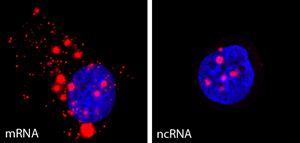What happens to gene transcription during DNA damage?

It's well known that when the DNA in a cell is damaged, the cell responds by activating specific genes that help defend the integrity of its genome. But less well studied is the fact that the cell actually shuts down the vast majority of its other genes.
For the first time, scientists at the Francis Crick Institute have analysed this phenomenon at the molecular level. They found that transcription of all genes slows rapidly and dramatically in response to DNA damage. They also discovered an example of a gene where a shorter non-coding version was transcribed because of this slowdown, and via so-called alternative splicing. This non-coding RNA then helps the cell to survive the DNA damage.
The importance of alternative splicing remains a matter of debate; while it was previously presumed that the process helps create great complexity in protein function from a limited number of genes, some researchers have recently insisted that alternative splicing cannot be important since proteomic analysis has shown that most genes only have a single protein form, implying that most alternative gene transcripts do not have a function.
The functional example of alternative splicing the Crick scientists describe is a gene called ASCC3. ASCC3 usually codes for a protein, but when there is DNA damage and gene transcription slows down, a much shorter RNA molecule is transcribed from the same gene instead. Remarkably, this form does not code for a protein so is known as a non-coding RNA. The researchers discovered that in fact, this alternative non-coding RNA is a stable transcript found in the cell's nucleus that plays a role in counteracting the original protein coded by the same gene.
Jesper Svejstrup, who led the work, says: "There may be many other genes like this; we certainly know there are scores of genes that appear to behave similarly in the DNA damage response. Such alternative non-coding RNA transcripts may also be up-regulated in response to other kinds of cellular stress. Indeed, many, many genes in the genome express short RNA forms that are almost always ignored because it makes no sense that they could code for proteins.
"Now that we know that BOTH a protein-coding and an alternative non-coding but functionally important RNA can be expressed from the same gene, researchers will start looking for functions for their short and potentially non-coding RNA transcripts in whatever physiological system they are working. Our work also illustrates the potential physiological relevance and relevance to disease of such unstudied transcripts."
The paper, UV-Irradiation Induces a Noncoding RNA that Functionally Opposes the Protein Encoded by the Same Gene, is published in Cell.
More information: Laura Williamson et al. UV Irradiation Induces a Non-coding RNA that Functionally Opposes the Protein Encoded by the Same Gene, Cell (2017). DOI: 10.1016/j.cell.2017.01.019
Journal information: Cell
Provided by The Francis Crick Institute



















